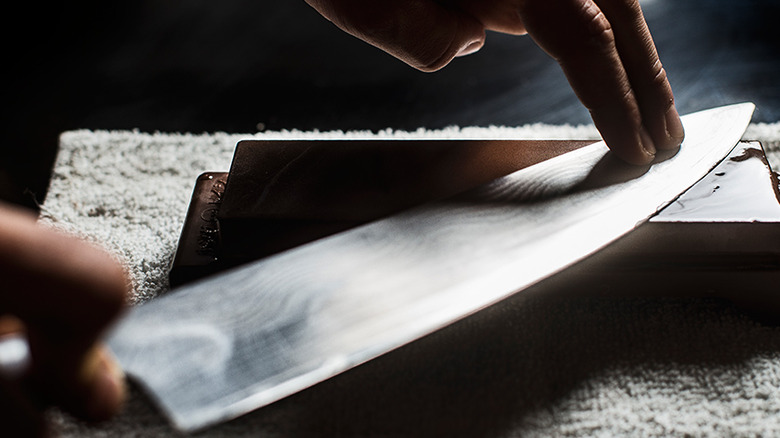Best Way To Sharpen A Knife With A Stone
Chef-approved tips for keeping your knives sharp
Todd Duplechan's love affair with knives began when he was required, at age 20, to purchase a $600 Japanese knife for one of his first kitchen jobs at a sushi restaurant in Denver. Years later, he still has that Masamoto Yanagiba sashimi knife—and a lot more blade knowledge.
Throughout Duplechan's career, he's been teaching himself about knives and traveling to L.A. to study at Japanese Knife Imports. Now, the chef/owner of the highly acclaimed Lenoir in Austin and adjacent culinary shop Métier Cook's Supply has designed his own craft-knife lines with Austin-based Weige Knives and Houston-based Serenity Knives— and still somehow finds the time to run whetstone knife-sharpening classes.
"The whole idea of whetstone sharpening is to maintain the longevity of your knives," Duplechan explains. "Mechanically sharpening knives (with a belt sander) takes off a lot more steel than doing it by hand, so you end up with a lot less knife a lot faster."

Soak the whetstone before sharpening
A common misconception is that a knife steel can be used to sharpen in lieu of a whetstone, when, in fact, a steel doesn't sharpen at all. "A steel just hones the knife edge in between sharpenings" Duplechan explains. "With a stone, you create a new edge and actually make the knife sharp again."
Sharpening stones, which can be made from a stone, diamond or ceramic, vary in grit. The lower the grit, the more metal they take off the blade. Most stones are two-sided, with a coarser side intended to smooth away roughness and a finer side for smoothing the blade to a razor-like edge.
RELATED How to Buy and Maintain a Handcrafted Kitchen Knife "
"What you're going for is that completely smooth, mirror-sharp edge, which is true sharpness," Duplechan, who recommends starting with a stone with 1000-grit and 4000-grit sides, says.
Knives are sharpened differently depending on the bevel. A 70/30 knife, for example, has a bevel of 70 on one side and 30 on the other. Therefore, it should be sharpened 70 percent of the time on the former side and 30 percent on the latter. Most standard chef's knives are an easy-to-remember 50/50, so they get sharpened equally on each side.
Sound complicated? "There's very little you can do to a well-made knife to really screw it up," Duplechan assures.
Here, his pointers on how to sharpen a chef's knife:
① Soak the whetstone in water for five to 10 minutes and continue to add water to the stone throughout the sharpening process.
② Hold the knife in your dominant hand with the blade facing you and its edge touching the 1000-grit stone, then lift the spine of the knife off the stone at a 15-to-18-degree angle. What does that look like? Imagine a matchbook is resting under the stone.
③ Apply downward pressure on the blade as you push it away from you and down the stone. Release the pressure as you pull the knife back toward you.
④ Continue until you feel a tiny burr, or nick in the metal, going from the end to the tip of the knife. A good method for beginners is to use a Sharpie to draw a tiny line along the edge of your blade, so you can see exactly where you're removing metal—you should be taking about one to two millimeters off the edge of your blade.
⑤ Once you have a burr running along one edge, turn the knife so the blade is now facing away from you. Using the same angle, apply pressure as you push the blade away from you and down the stone, then release as you pull it back in toward yourself. Duplechan recommends counting knife strokes to make sure you're sharpening both sides evenly.
⑥ Once both sides have been smoothed into a new edge, your knife is already sharp and usable. But flip the stone to the 4000-grit side and use the same method of sharpening on each side until the blade is finished to razor-sharp perfection.
